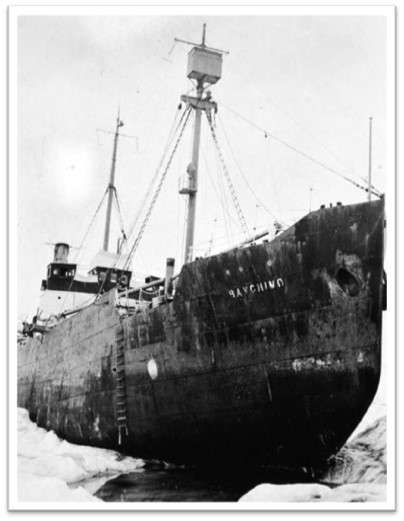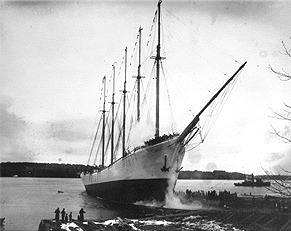The Ourang Medan is a legendary ghost ship purportedly discovered adrift in the Strait of Malacca in the late 1940s, with its entire crew mysteriously dead, exhibiting terrified expressions and no visible injuries.

According to maritime lore, shortly after the bodies were found, the ship mysteriously caught fire and exploded, sinking to the bottom of the sea and destroying any evidence that could explain the bizarre incident.
Despite extensive discussions and theories ranging from hazardous cargo to paranormal activity, no verifiable records of the ship’s existence or the exact circumstances of the tragedy have ever been confirmed, leaving the Ourang Medan as one of the sea’s most enduring mysteries.
Discovery of the Ourang Medan
The enigmatic tale of the Ourang Medan begins with a sequence of distress calls intercepted by multiple ships stationed near the Strait of Malacca in either 1947 or 1948, although the exact year remains part of the mystery.
The distress signals were initially received in Morse code and relayed a harrowing message of despair: “SOS from Ourang Medan … we float. All officers including the Captain, dead in chartroom and on the bridge.
Probably whole of crew dead …”
This initial transmission was followed by a series of garbled and indecipherable Morse sequences which culminated in a final, grim statement: “I die.”
Prompted by these ominous messages, the Silver Star, a nearby American merchant vessel, decided to approach the Ourang Medan in an attempt to rescue any survivors and investigate the situation.
Upon locating the ship, the crew of the Silver Star observed that the Ourang Medan appeared outwardly normal, drifting without visible damage or distress signals.
However, the reality they encountered upon boarding was starkly different and deeply disturbing.
The decks of the Ourang Medan were littered with the corpses of the crew.
Each body, including that of the ship’s dog, was found sprawled on their backs, faces upturned with mouths agape and eyes staring blankly towards the sky, as if in terror.
Strikingly, there were no signs of physical injuries on the bodies, no blood, no visible wounds, suggesting that whatever catastrophe had overtaken them had not been violent in nature.
 The SS Baychimo is another spooky ghost ship story that you can read Here.
The SS Baychimo is another spooky ghost ship story that you can read Here.
As the rescuers ventured further into the ship, they noted that the air was markedly cold, and a mysterious chill seemed to hang over the scenes of death. This chilling atmosphere added an eerie quality to the already grim tableau.
The radio operator, who had presumably sent the distress calls, was found dead at his station, his fingertips resting on the Morse code transmitting device, as if he had died in the midst of his final plea for help.
Intriguingly, just as the mystery seemed deep enough, a fire unexpectedly broke out in the cargo hold of the Ourang Medan. This swiftly forced the rescue team to retreat back to the Silver Star.
The fire quickly grew out of control, and not long after the evacuation, the Ourang Medan reportedly exploded with such force that it sank to the bottom of the sea, taking with it any definitive evidence or clues that could have shed light on the cause of the deaths or the nature of the cargo that might have contributed to the catastrophic end of the vessel.
This tragic and mysterious end not only intensified the enigma but also left more questions than answers regarding what truly happened on the Ourang Medan.
The ship’s final moments remain cloaked in mystery, preserved only in the echoes of its distress calls and the haunting memories of those who witnessed its demise.
Theories Surrounding the Mystery
The Ourang Medan’s eerie demise has spawned a plethora of theories and investigations, though the absence of physical evidence, given the ship’s explosive destruction, has led to more speculation than concrete answers.
These theories range from scientifically plausible to wildly supernatural.
Unsecured Hazardous Cargo: One of the most widely accepted theories is that the Ourang Medan was illegally transporting a cargo of hazardous chemicals, which might have included nerve agents or other toxic substances leftover from World War II.
Supporters of this theory suggest that seawater might have entered the ship’s hold due to poor weather conditions or lack of maintenance, reacting with the cargo to release toxic gases.
This could have led to the asphyxiation or poisoning of the crew.
Furthermore, such chemicals could potentially react explosively with water, which might explain the sudden fire and subsequent explosion that destroyed the ship.
This scenario is cited to highlight the dangers and moral consequences of transporting hazardous materials clandestinely.
Carbon Monoxide Poisoning: Another theory suggests carbon monoxide poisoning as the cause of death for the Ourang Medan crew.
This could have occurred through malfunctioning boilers or improper ventilation systems, common issues in poorly maintained ships.
Carbon monoxide, being a colorless and odorless gas, could have killed the crew quickly and without any visible signs of trauma, which aligns with the condition in which the bodies were reportedly found.
However, this theory does not fully account for the reportedly terrified expressions on the faces of the deceased or the mysterious chill observed by the rescue team.
 Possibly the most famous ghost ship is the Mary Celeste.
Possibly the most famous ghost ship is the Mary Celeste.
Piracy or Foul Play: Given the strategic location where the ship was found, another theory revolves around an attack by pirates, which was not uncommon in the notoriously pirate-infested waters of Southeast Asia at the time.
Some speculate that the crew might have been poisoned or suffocated by pirates, who then ransacked the ship.
However, this theory is less favored as it fails to explain the lack of physical disturbances or the unscathed state of the ship’s cargo and equipment.
Paranormal Explanations: In the absence of tangible evidence and due to the odd circumstances surrounding the deaths, some theories veer into the realm of the paranormal.
These include speculations about ghostly forces or extraterrestrial involvement, citing the mysterious final messages and the unnatural postures of the bodies as potential indicators of supernatural occurrences.
Misinformation or Exaggeration: A more skeptical view suggests that the entire story might be an elaborate maritime myth.
Historians and researchers like Roy Bainton and Dr. Giles Milton have pointed out inconsistencies in historical records and the lack of verifiable sources, proposing that the story might have been exaggerated or even fabricated.
This perspective encourages a critical examination of maritime legends and their origins, emphasizing the blending of fact and fiction in seafaring folklore.
Each of these theories attempts to provide an explanation for the Ourang Medan’s mystery, but without the shipwreck to examine or official logs to consult, the truth remains as elusive as ever.
Criticism of the Ourang Medan Story
The Ourang Medan story, while captivating and chilling, is shrouded in a considerable amount of skepticism regarding its authenticity.
The lack of concrete evidence and the absence of verifiable documentation have led many to question whether the incident ever occurred at all.
One of the most significant red flags concerning the Ourang Medan’s story is the complete absence of any official registration or shipping records.
Ships of any notable size and purpose are typically well-documented through logs, registration details, and crew manifests, all of which seem to be non-existent for the Ourang Medan.
This absence is highly unusual and raises questions about whether the ship was fictional or perhaps operating under a different name or flag than reported in the stories.
Researchers who have delved into the mystery often cite discrepancies in the dates and locations associated with the story.
Different accounts place the incident in slightly varying years (1940, 1947, or 1948) and locations, which complicates efforts to verify the story through contemporary newspaper reports or governmental records.
Such inconsistencies contribute to the skepticism surrounding the ship’s existence and the events that allegedly occurred aboard.
 The Carroll A. Deering was a ghost ship found in 1921.
The Carroll A. Deering was a ghost ship found in 1921.
The primary sources of the Ourang Medan story are a mixture of anecdotal reports and second-hand accounts.
One of the earliest mentions comes from a series of articles in Dutch-Indonesian newspapers in the 1940s, and later, the story was popularized by the proceedings of the Merchant Marine Council, published by the U.S. Coast Guard in 1952.
However, these sources often lack corroborative details and do not cite any direct evidence or firsthand accounts, leading to questions about their reliability and the veracity of the information provided.
The Ourang Medan story has been perpetuated and perhaps embellished through its retelling in books, magazines, and by word of mouth.
The dramatic elements of the tale—such as the mysterious last message “I die” and the gruesome state of the crew—make it a compelling story for sensationalist reporting and paranormal literature.
This has likely contributed to both the spread and the distortion of the original events, whatever they might have been.
Prominent historians and maritime researchers, including Roy Bainton and Dr. Giles Milton, have approached the Ourang Medan story with a critical eye.
They argue that the lack of evidence and the narrative inconsistencies likely indicate that the story is either wholly fabricated or a gross exaggeration of a less dramatic incident.
Their work encourages a more skeptical evaluation of maritime legends, emphasizing the importance of evidence in distinguishing between historical events and folklore.





